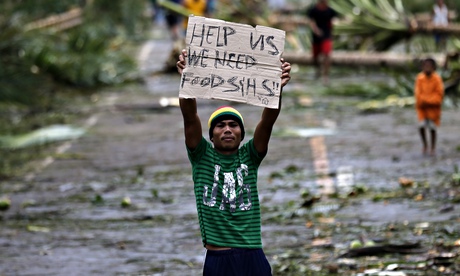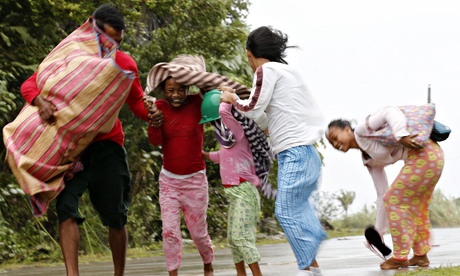Tropical storm Mangkhut continued on its destructive path on Sunday as it hit the southern coast of China, killing two, after leaving at least 64 dead in the Philippines amid landslides and flooding.
The storm, which has been downgraded from typhoon status, battered the heavily populated Guangdong region on Sunday afternoon with 100mph (160km/h) winds, after skirting 62 miles from Hong Kong.
In Guangdong, more than 2.4 million people have been evacuated. The storm made landfall in the the city of Haiyan around 5pm local time, according to China’s central meteorological observatory.
China Central Television said Mangkhut, which the China Meteorological Administration called the “King of Storms”, triggered storm surges as high as 3 meters. By Monday morning, the Chinese state broadcaster said four lives had already been lost.
Schools have closed until Tuesday, the high-speed rail line has been suspended and hundreds of flights have been cancelled, according to China’s state news agency, Xinhua. In the southern province of Fujian, officials have ordered thousands of fishing boats to return to harbour and closed construction sites near the coast.
#TyphoonManghkut pic.twitter.com/xinZeFanPa
— Jacky Wong (@jackycwong) September 16, 2018
As the storm brushed passed Hong Kong, high winds smashed windows in the city, tearing off parts of buildings and roofs, while storm surges flooded hotels and restaurants with waters waist-deep. More than 100 people were injured. The neighbouring Chinese gambling enclave of Macau also closed all 42 of its casinos for the first time.
In the Philippines, the total death toll rose to 64. The heaviest casualties were in Benguet province, where 38 people died, mostly in two landslides, and 37 are still missing, the police said. Dozens of people, mostly small-scale miners and their families, are still feared to have been trapped by a landslide in the far-flung village of Ucab in Itogon town in the province, according to the local mayor, Victorio Palangdan. Supt Pelita Tacio said 34 villagers had died.
Four others – including two children – were buried in a landslide in Nueva Ecija, another person died in Kalinga, and one was killed by a falling tree in Ilocos Sur, said Francis Tolentino, an adviser to President Rodrigo Duterte. A pregnant woman was also among the fatalities.
The storm, the strongest in the region this year, was not as ferocious as feared due to the remote areas where the typhoon hit. However, the full death toll and extent of the destruction is still unknown.
On Sunday, Duterte and government officials flew to the heavily impacted area of Cagayan. He said in a televised briefing: “I share the grief of those who lost their loved ones. Those [are what] we call the unforeseen events. In insurance, this is an act of God. I don’t know how it can be an act of God, but that is the term used by the insurance.” Tolentino said the search and rescue operation had ended and the focus would switch to rehabilitation and the restoration of power and water supplies.
Ma Wan, off the eastern edge of #HongKong's Lantau Island, feels the force of #Mangkhut https://t.co/vw3rCPfflY #TyphoonMangkhut 🎥: Sian Loh pic.twitter.com/UHRQq0bKKU
— SCMP News (@SCMPNews) September 16, 2018
The category five super-typhoon hit the northern end of the Philippine island of Luzon early on Saturday morning, with the high winds ripping roofs off houses and pulling down trees and electricity pylons, and the rains causing fatal landslides and flooding. More than 5 million people were in its path.
The island is a key agricultural area in the Philippines, producing most of the country’s rice, corn and other vegetable crops, which have been ruined a month before harvest, damaging the livelihoods of thousands in the region.
In Ilocos Norte where the typhoon made its exit, Juan Carlo Tabios, 22, and his family thought they could stay in their wooden bungalow home and ride out the typhoon.
They were forced to evacuate at the last minute when the howling winds started to shake the house at midnight on Saturday. They ran to a neighbour with a sturdier house, where they they heard the typhoon rip their home apart, piece by piece.
“The walls of our home flapped against the strong winds for hours and stopped only when they broke off,” said Tabio. “In the morning, we saw that our home was totally damaged. The kitchen was completely washed out. My room was split open and my clothes and books were soaked.”
Jerome Balinton, a spokesman for Save the Children who was in north-eastern Luzon, said: “The further north we travelled the more extensive the damage, particularly in Cagayan province. House after house had been flattened or badly damaged, with roofs or walls missing. Large trees have been uprooted from the ground and power poles bent right over, leaving power lines strewn across the ground.”
He added: “In some areas where the eye of the storm hit, it seems as if nothing has been left undamaged.”
The typhoon affected 250,000 people in Luzon, according to the government’s natural disaster council. Mangkhut, a Thai word for the mangosteen fruit, is the 15th storm this year to batter the Philippines.













